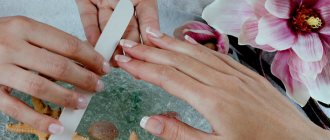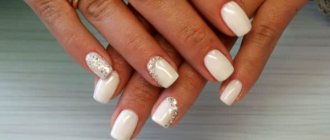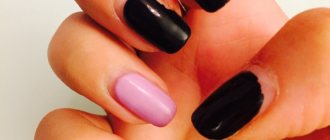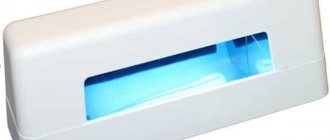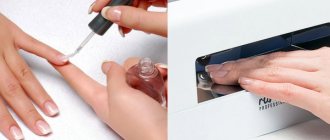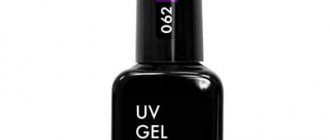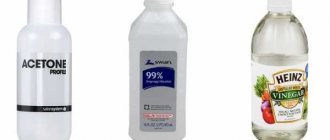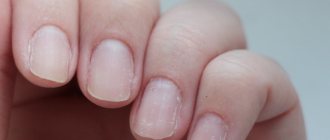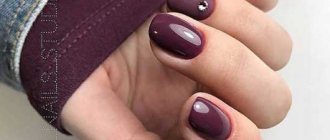Nowadays, every person wants to look attractive and beautiful. And beautiful nails are an integral part of an attractive look. The most popular today are two procedures: nail extensions and shellac. Despite the fact that these are quite different methods, many representatives of the fair sex cannot make a choice for a long time. Should I choose shellac or extensions? What are their features, advantages and disadvantages?
To answer these questions, you need to know exactly what the nail extension procedure and shellac are.
The nail extension procedure involves increasing the length of nails using a special gel or acrylic.
Shellac is a procedure during which the nails are simply covered with gel. Thus, the nail plate acquires greater strength and becomes stronger, healthier, and more attractive. It is worth noting that the length of the nail does not increase, it simply becomes stronger and more beautiful. An important advantage is that the nail polish lasts for a long time.
Price and benefit
The price certainly varies. Gel polish is cheaper, since the cost of materials and labor costs for implementation are different.
But what is more profitable in the end is another question. Gel polish, if it begins to come off, cannot be corrected. You need to remove it, while paying for removal, and then apply a new coating. It is almost impossible to fix one nail, since they will be completely different in appearance.
But a damaged nail extension can be corrected individually, and at the same time without any problems adjusting the overall look into a single ensemble and even changing the design. After all, these nails are not afraid of sawdust and surface polishing.
Therefore, extensions are still more profitable if you wear artificial nails on a regular basis.
Comparison
Features of extension
Extensions are made using tips (plastic, paper, liquid or others) - special plates that are initially glued to the nail. Afterwards they are filed to the required length and given the desired shape. The tips contain the material from which the nail is actually extended, so they remain on the plate until complete polymerization, and then are removed. The resulting nails are trimmed with a nail file, sanded and polished.
Then everything is at the request of the client - the color of the varnish, the design and the rest. This manicure is durable and protects the natural nail from external factors, as well as from mechanical damage.
The disadvantages include the need for regular correction, because a nail that has grown at the base looks unaesthetic, but the same disadvantage applies to shellac coating. Secondly, extension materials can cause allergies or damage to the structure of the nail plate, even tearing it off from the root. In addition, the procedure is not advisable during pregnancy or during treatment with hormones, since there is a possibility that natural nails will reject the material.
Features of shellac
Gel polish coating is a simpler procedure that does not change the length and structure of the nail. The natural plate is filed to the desired size and shape, sanded so as to remove the top shiny layer, otherwise the shellac will look sloppy. Afterwards, the nails are covered with a disinfectant, a base coat, two (the quantity is determined by the master) layers of colored varnish and a top coat. Each stage is accompanied by drying in a UV lamp. The last thing is to remove the sticky layer and apply oil to the cuticle.
As a result, the nail plate becomes thicker, the color of the varnish looks more saturated and lasts much longer - up to three weeks. Next you need to make a correction.
Despite all the differences between shellac and extensions, both procedures have some similarities. If the master did not do his job very well, the coating may soon crack or chip. In addition, health conditions can cause damage to shellac or artificial nails. For example, the functioning of the thyroid gland even affects artificial manicure - the color may fade or change altogether, and the nail itself may crack after a day or two.
Harmfulness of materials
If we talk about harmfulness, then chemistry is this and that. Another question is that its effect on the body in such quantities is insignificant for the salon client. But for a master who does this professionally, of course there is a difference.
Gel polish, when applied, does not have a lot of dust from sawdust, as with extension technology. And dust, as you know, is a bad thing. But, if you follow safety precautions and use a respirator during the procedure, then there is no difference in harm and there cannot be.
Description of shellac coating
What is the difference between shellac and gel polish and what kind of procedure is it? Let's figure it out. It is intended for those who love varnish manicure. At the same time, it places increased demands on it: it must dry instantly, not chip, be worn for a long time and not wear out.
Shellac is an excellent alternative to gel or acrylic; it strengthens the nail plate. It should be applied using a certain technology. This material is designed to cover natural nails.
Using shellac you can hide peeling, brittle and fragile nail plates. It lays on the nail as a weightless protective layer and provides it with mechanical protection. It has already been appreciated by young mothers who don’t have time to do a new manicure every three days, business women - they always need to look at their best, and chipped varnish will reveal their negligence.
On the video what is shellac nails:
Shellac does not spoil nails, does not fade or fade even with prolonged wear, and creates an excellent manicure appearance. The period of wearing it is 20 days on the arms and 6 weeks on the legs. Such indicators are due to the growth of the nail, so some girls need to repeat the procedure more often, and for others less often.
The material is easy to apply. If you already have a special UV lamp at home for drying nails, then you can safely buy such a varnish and conduct experiments.
Is it harmful to nails?
It consists of unique components that allow you to strengthen natural thin nails; the material creates a shock-absorbing layer, thanks to which the nail does not break even under mechanical stress, scratches and impacts. After proper drying, you should not wet your hands for an hour; when this time passes, the nail plates are no longer afraid of anything.
This material is odorless, so there will be no discomfort when working with it. Unlike conventional varnishes, it does not contain formaldehyde, dibutyl phthalate and toluene, therefore it does not harm the nail plate, and is also absolutely hypoallergenic. It is used according to the principle of ease of application and ideal durability. Drying shellac on nails occurs under an ultraviolet lamp, the same as for gel polish.
On the video - is shellac harmful for nails, reviews:
Contraindications
Are there any contraindications? It turns out that it is not the coating itself that affects the condition of the nails, but the procedure for removing it. If you do it at home incorrectly, you may encounter delamination and damage to the top layer. This is due to the use of acetone and other shellac removers.
They act aggressively on nails, but this is not excluded when using regular varnish. In addition, when using the latter, the solvent is used much more often, almost every three days, and when using shellac, you only need to remove it once every three weeks. If you approach the situation in this way, then your nails will only benefit from the procedure for applying the gel composition.
It turns out that the stronger the solvent, the more it damages the nails and also dries out the skin around them. Beauty salons take this fact into account, so they use special soft liquids enriched with medicinal plant extracts and fats. For example, ethyl acetate, the composition of which is similar to nourishing cream.
It contains oil components, beneficial vitamins B5 and E. Some products contain glycerin, which moisturizes the nails and makes them elastic . When choosing a remover in the form of acetone, you should try not to use it less than once a week, and soft liquids should be used no more than twice a week, but when using shellac, these restrictions are unnecessary, since it has to be removed no more than once every two weeks.
When removing shellac, you need to have a special stick, with the help of which the remaining coating is removed from the nail plate. You need to be careful with it, otherwise you can damage not only your nails, but also your skin, and then it will take a long time to restore them. For the first time, it is better to seek help from a specialist, and after the lesson learned, fix it yourself at home; in extreme cases, you can use a training video on removing shellac at home.
After the removal procedure and application of the next coating, it is advisable to take short breaks to allow the nails to recover, help them become stronger by rubbing mineral oils and plant extracts into them.
If we consider how the process of applying shellac affects the entire body, then we should not forget that a UV lamp is used to dry the material on the nails, which uses ultraviolet rays.
Why nails hurt after shellac is detailed in this article.
It’s also worth understanding how to quickly restore nails after shellac.
Why shellac doesn’t stick well to nails is detailed here: https://soinpeau.ru/spa/nogti/pochemu-shellak-ne-derzhitsya-na-nogtyax.html
But how to choose a lamp for shellac is detailed in this article.
Of course, you could wait for the varnish to dry naturally, but this would take a lot of time, and one layer dries in just one minute.
But during this time, the rays emanating from the lamp can provide a carcinogenic effect, so doctors advise to protect yourself and during the procedure of such a manicure use sunscreens or creams with at least a minimum degree of protection - SPF 15, and it is better to use drugs with a higher index.
Durability of wear
Gel polish lasts 3 weeks. But this is theoretical... But in practice, the nail grows much faster and after a week and a half, an ugly bald spot forms in place of the cuticle, which is difficult to hide. Even if you cover the top with fresh varnish, a small transition will still be visible. But gel polish can’t tolerate filing; it will simply peel off.
Extended nails last much longer and, when they grow back, you can easily file them at the cuticles and paint them with varnish.
Extended nails last longer, again, theoretically. If you dig the ground with them and open beer bottles with your nails, then you yourself understand...
How much does the procedure cost?
The prices for such coverage vary widely, depending on the region in which you live. They are also influenced by the quality of the material and tools used, because you can buy cheap raw materials. The UV lamp, the product itself and the fixative for it can be found on numerous Chinese wholesale sites.
The price of the issue will depend on where the procedure is performed; if you decide to perform it at home, then you need to take into account that initially you need to purchase a starter kit of everything you need, its price on average is 5,000 rubles. But you can buy everything gradually. But then you won’t have to spend money every month on an expensive procedure in the salon.
Salon prices for shellac coating range from 1000-1500 rubles, and its price with removal of the previous coating reaches 2000 rubles.
The entire process of using shellac is accompanied by pleasant sensations. After completing the procedure, the master applies softening oil to the cuticle, preventing it from drying out, and then massages the hands with a nourishing cream to remove the drying effect of the ultraviolet lamp rays. Shellac can not only decorate nails, but also make them stronger, eliminate their fragility and accelerate growth. After this procedure, you no longer need to worry about accidental scratches and chips; shellac will prevent them from appearing on its surface.
But why you need a primer for shellac can be understood if you read the contents of this article.
It’s also worth understanding what you need for shellac at home.
But why you need a primer for gel polish is detailed in the contents of this article.
It’s also worth understanding which primer is best for gel polish, which is described in detail in this article.
You may also be interested in learning about how to coat your nails to make the polish last longer.
What is gel polish and gel nail extension?
Gel polish and gel are materials for coating and extending the nail plate. Thanks to them, you can eliminate nail defects or lengthen the free edge.
How does gel polish work? Advantages and disadvantages
Gel polish is a combination of regular nail polish and bio-gel. Its dispersion medium forms a checkered component on the surface of the nail plate, due to which the material adheres. The gel polish hardens due to polymerization in an ultraviolet and LED lamp.
Gel polishes are divided into:
- reflective (characterized by quick adhesion to the nail plate, dried in a lamp);
- not reflective (applied using a catalyst).
Most often, craftsmen use reflective gel polishes, as they are easier to use.
Gel polish is suitable for those who have a dense nail structure.
The advantages of gel polish are as follows:
- relatively harmless, even during pregnancy;
- covers the nail plate with a thin layer;
- ease of application (similar to regular varnish with a brush);
- resistant to mechanical damage with proper care;
- does not have a pungent chemical odor;
- has a wide color palette;
- there is a special line of gel polishes for children, enriched with vitamins;
- retains the original appearance of the coating for a long time;
- no peeling when applied correctly;
- due to the plasticity of the material, it does not deform the nail;
- has a high polymerization rate;
- looks natural;
- has a glossy shine;
- can be easily removed by soaking with a special compound.
Among the disadvantages of using gel polish are:
- inability to adjust the shape and length of the nail;
- fades in the sun;
- cheap and low-quality material can cause allergies, rashes and respiratory problems;
- less wear resistance compared to gel coating;
- when worn for a long time, the material begins to actively absorb moisture, drying out the natural nail, and voids form on it, which damage the nail plate;
- may cause exacerbation of existing fungal infections, as well as dermatological problems;
- budget gel polishes from some manufacturers contain substances that are toxic and harmful to the body;
- drying the material in a lamp can cause discomfort and burning;
- It is not recommended to apply to long nails, as the likelihood of chipping increases;
- Wearing gel polish for a long time without interruption thins the nail.
The principle of operation of the gel. Advantages and disadvantages
Gel is a porous artificial polymer material that is used for extension and coating of natural nails. Using the gel, you can lengthen the free edge, form the desired shape and strengthen the thin nail plate.
There are such types of gel as:
- basic (gel of liquid consistency, which is necessary for better adhesion of the material to the nail plate);
- modeling (used to create the shape and increase the length of the nail);
- finishing (used to provide a glossy surface of the material).
There are also gels that combine the properties of different types of material.
Among the advantages of using the gel are the following:
- high coating strength;
- minimal negative impact on the nail structure;
- the ability to create creative designs on nails using broths, rhinestones, stones;
- correction of the shape of the nail and alignment of the plate;
- lengthening the nail plate;
- good durability of the coating on peeling nails;
- giving a healthy appearance to the cuticle by moisturizing it;
- long wear time;
- no deformation when wearing;
- economical consumption of material.
Helium coating also has its disadvantages:
- meager color palette;
- removal only by sawing;
- danger of injury when the material is chipped;
- burning sensation during polymerization in a lamp;
- under the gel, the natural nail grows faster, since the material blocks the access of oxygen;
- if performed poorly, unnatural appearance;
- extended nails are more brittle due to their length;
- Removal of the gel coating cannot be done independently;
- The gel may crack due to sudden temperature changes.
Gel polish or biogel?
Alisa Patrakeeva, manicurist: “Soluble gel polishes are the newest type of coating. Now there are already a lot of manufacturers of such products, but the most famous among us are Shellac from CND (USA), Gelish from Nail Harmony, Axxium from OPI (USA). All these products are absolutely identical. But they are all called shellac now, just as all cat food is called Whiskas, or all copiers are called Xerox.”
Advantages of gel polish compared to biogel:
• nails look absolutely natural (when using biogel, the nail looks thicker);
• faster to apply and remove;
• does not require sawing off the plate at all (for biogel, the thin top layer is still sawed off);
• protects nails from the effects of household chemicals, nails do not peel off;
• ideal for pedicure (nails look well-groomed for more than a month, without requiring repainting; in addition, it is possible to restore nails on the little toes deformed by shoes).
Advantages of biogel compared to gel polish:
• strengthens the nail much better;
• has more design options.
By the way, the prefix “bio” in the name is just a marketing ploy, and if you still think that “bio” guarantees you some kind of recovery, then you are mistaken.
Source
Building up
Extension is the process of artificially increasing the length of the nail in order to correct defects in the natural nail (delamination, weakness and brittleness of the nail plate, etc.). A special gel is applied to tips or forms, depending on the preference of the chosen master.
Tips are plastic blanks that are glued to the nail plate, after which gel is applied to them. However, extensions using tips are still considered outdated; now modern masters use special forms. They are tightly applied to the skin, on the backing there is a pattern of boundaries along which the length and width of the extension is formed. After gluing the forms, the selected color and a final layer of topcoat are applied to them. After application, each gel requires drying in an ultraviolet lamp. After the procedure is completed, the forms are deleted.
Extensions are intended for people with thin nail plates; in this case, growing the required length is problematic. With its help it is also easy to adjust and make any shape. Some find it difficult to grow the desired length or small size of the nail plate; for them, extensions are an excellent solution.
Also suitable for uneven plates , a layer of gel thickens it and levels it out, creating a smooth surface. On many nails, gel polish comes off in pieces or peels off like regular polish. In this case, artificial coating is a suitable solution to extend the life of the varnish.
When carrying out the procedure, you need to take a responsible approach to choosing a specialist, so that in the end the extensions look natural and the nails do not break.
Acrylic or gel?
Alisa Patrakeeva, manicurist: “Nowadays in the nail service it is customary to talk not only about nail extensions, but about nail modeling. Using acrylic and gel, defects in the client’s nail plate are corrected. Nails can be different: downward growing, springboard-shaped (the tip “looks” up), it happens that the nails grow slightly to the side, and not straight. Modeling corrects defects in natural nails.”
Acrylic technology
Pros of acrylic:
• acrylic nails are more durable than gel nails, since the density of acrylic is higher than that of gel;
• you can remove acrylic nails, unlike gel nails, using a special solution without filing them;
• acrylic French looks more natural than gel;
• it is best to correct nail defects with acrylic, since it is possible to “sculpt” the nail, but the gel only spreads.
Cons of acrylic:
• unpleasant, pungent odor of monomer during the extension procedure;
• some types of acrylic acquire a yellowish tint when removing brightly colored nail polish (by the way, you can only use liquid without acetone for acrylic nails);
• acrylic nails are more difficult to do from a professional point of view, so it is difficult to find a good nail technician.
Gel technology
Pros of the gel:
• since the gel is more like glass, some types of designs look more interesting under it, for example dried flowers;
• easier to find a master.
Cons of the gel:
• gel nails can only be removed by filing;
It is important to remember that none of these materials are worse or better. They're just different. And you need to determine what is right for you.
Some tips for wearing artificial nails:
• If you have never had long nails, grow your nails a little longer first so that you gradually get used to them.
• On the buttons of the telephone, remote control, etc. It is better to press only with pads, not to knock on the table, keyboard keys, etc. Many people, believing that artificial nails are more durable than natural ones, begin to put more stress on them, which leads to disastrous consequences.
• To keep your nails healthy, you need to nourish not the nail plate itself, but the root of the nail, which is located just below the cuticle. This is where the nail is formed. If you nourish this place with oils and creams, the nail plate will grow healthier.
• If you decide to remove artificial nails, then after this you can take several paraffin baths in a beauty salon to restore the nail plates. We can talk about complete restoration of the nail plate after extensions only after the nail has completely grown back, that is, after a couple of months. But, as a rule, if artificial nails are removed correctly, no dangerous consequences should be expected, but just remember that your nails are now thinner and need to be handled with care.
By the way, extended or strengthened nails save you from bad habits (squeezing pimples, picking cuticles - this is simply impossible to do with thick nails). Extensions help you get rid of the habit of biting your nails and restore your nail bed. On the other hand, with artificial nails it will be difficult for you to do some useful small work (fasten an earring, chain, etc.)
Do I need to apply a base coat to extended nails?
Artificial nails do not need to be coated with primer, but degreasing the nail plate is essential. Some people recommend using a base. It is needed so that the gel polish adheres to the surface of the extended nails. ... Base coating on artificial nails is not critical.
Interesting materials:
How to tell cast iron from iron? How can you tell if a frying pan is cast iron or not? How to determine the visual range of binoculars? How to determine the manufacturing date of a product? How to determine the date of Orthodox Easter? How to determine date in Excel? How to determine the release date of a Samsung TV? How to determine the pressure of a solid? How to determine the participial phrase in the text? How to determine deficiency or excess?
What common
These two procedures are identical , and practically the same materials and tools are used. Before applying color coating or performing extensions, a hygienic manicure is required. When performed, the cuticle is processed and removed, the length is adjusted and filed.
Manicure is done in both cases and is done in several stages:
- Applying primer to the nail.
- The next stage is using the base.
- After drying, the base layer is covered with the selected color, and when building up, it is coated with gel.
- The final stage is applying the top.
To create a long-lasting manicure, an LED UV or ice lamp is used to dry each layer. When contacting water and cleaning products, it is better to wear gloves.
When extensions are made, the length will interfere with homework. If even a small crack accidentally appears, it is better to immediately contact a specialist so that he can repair or redo the manicure.
The methods differ:
- The time it takes to complete the procedure . Creating artificial nails takes longer than a manicure with gel polish. coating. The extension takes 3-4 hours, not every girl will spend the allotted time. Gel polish is done much faster.
- Gel polish strengthens and does not damage the nail plate . When building up, the top layer of the plate is cut off, causing it to become thinner and weaker.
- about 10-20 minutes to remove the gel polish ; the extensions can be cut off in up to 1.5 hours .
- The price for extensions is much higher than for regular shellac.
